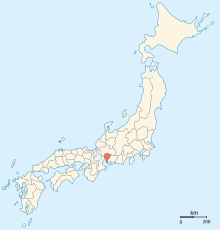Battle of Okehazama

The Battle of Okehazama ( Japanese 桶 狭 間 の 戦 い Okehazama no tatakai ) or Battle of Dengakuhazama ( 田 楽 狭 間 の 戦 い , Dengakuhazama no tatakai ) was a decisive battle in the Japanese Sengoku period and took place on June 12, 1560 ( traditionally : Eiroku 3/5/19) at today's Toyoake . It was here that the three unifying parties met for the first time .
meaning
The outcome of the Battle of Dengakuhazama sealed the fall of one of the most influential Sengoku daimyō houses, the Imagawa , and at the same time the rise of the first of the later three unified empires, Oda Nobunaga , from a provincial ruler to one of the most influential and formative people of the time; and with it the beginning of the Oda influence on the national history of Japan. The most influential ruler of the Imagawa, Imagawa Yoshimoto , was killed despite having gathered an estimated ten times the number of his opponents' troops. In addition, the second of the three unifiers, Toyotomi Hideyoshi, rose from an Imagawa follower to a general under Oda Nobunaga and also began to exert influence.
Course of events
Imagawa Yoshimoto had started the march on the capital of the Tennō Kyōto from his home province Suruga in order to be appointed the new Shogun . With about 25,000 men (the chronicler of the Imagawa wrote 40,000) he invaded the province of Owari of Oda Nobunaga, bordering his province to the west of his Mikawa province , in 1560 and had the border fortifications of Washizu and Marune razed . Oda Nobunaga, however, hastily rallied troops, though outnumbered, and faced his opponent.
Imagawa Yoshimoto set up camp near Okehazama Village in Dengakuhazama Valley. After the initial successes, his troops celebrated with certainty of victory. Some well-known fighters such as Hattori Hanzo were in his ranks. At night, in a severe storm, Oda Nobunaga led a surprise attack with only about 2,000 to 3,000 men, it is said that farmers dropped their tools in the field and followed him because his entourage looked so meager that there was no hope of victory given. He had one part attacked head-on, and with another he had bypassed the valley and approached from behind through a forest. Distracted by the noise of the storm and alcohol, and overwhelmed by the two-way tactics, Yoshimoto died with many of the Imagawa vassals - Yui Masanobu ( 由 比 正 信 ), Ichinomiya Munekore ( 一 宮 宗 是 ), Matsui Manenobu ( 松井 宗 信 ) and Ii Naomori ( 井 伊 直 盛 ). Many other officers, including Toyotomi Hideyoshi , subsequently joined Oda Nobunaga . In the battle, all three unmistakers , Oda Nobunaga , Toyotomi Hideyoshi and for the Imagawa Tokugawa Ieyasu took part.
As a result, Oda Nobunaga began his campaigns of conquest , while Imagawa Ujizane could not avert the decline caused by the death of his father.
Reception today
The battle was also re- enacted in the Japanese historical drama Furin Kazan in season 1 episode 45 with many well-known actors.
The former battlefield is now a park with monuments. The place is conveyed as a historical place of national rank in the history curriculum.
literature
- Ōta Gyūichi: The Chronicle of Lord Nobunaga (= Brill's Japanese Studies Library. 36). Brill, Leiden et al. 2011, ISBN 978-90-04-20162-0 .
- Stephen Turnbull : Battles of the Samurai. Arms and Armor Press, London 1987, ISBN 0-85368-826-5 .
Web links
Individual evidence
- ↑ oocities.org
- ^ Battle of Okehazama. wiki.samurai-archives.com, accessed January 5, 2015 .
- ^ Battle of Okehazama. sengoku-period.wikia.com, accessed January 5, 2015 .
- ^ Richard Bowring, Peter Kornicki (ed.): The Cambridge Encyclopedia of Japan. Cambridge University Press, Cambridge et al. 1993, ISBN 0-521-40352-9 , p. 65, right-hand side from the second paragraph.
- ^ John Whitney Hall : Japan. From Prehistory To Modern Times (= Michigan Classics in Japanese Studies. 7). The University of Michigan - Center for Japanese Studies, Ann Arbor MI 1991, ISBN 0-939512-54-8 , p. 143.
- ^ Britannica.com

